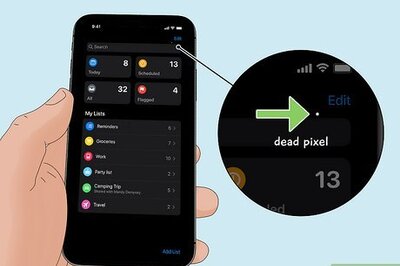
views
What are body types?
They are 3 general body shapes people may fall into. The body type theory was first introduced in the 1940s by Dr. William H. Sheldon. His theory was that your body type is genetic, and it’s not possible to change it. He proposed 3 main body types, or somatotypes, that people fall into. Somatotyping is only one way of classifying the shape and structure of human bodies, but it is one of the most common. Ectomorph: Ectomorphs are thought to have a thin, wiry frame with small shoulders and hips, long limbs, and less muscle mass than other types. Mesomorph: Mesomorphs are believed to be of a medium build with a low body fat percentage. They may have broad shoulders and a muscular chest, shoulders, arms, and legs. Endomorph: Some believe endomorphs have a larger, rounder body shape, high levels of body fat and muscles, as well as shorter arms and legs. They tend to gain weight more easily.
Diet & Exercise Tips for the 3 Major Body Types
Endomorphs often have more fat and muscle. Many believe endomorphs are generally unhealthy and don’t do well with athletic activities. Because of this, trainers often give specific recommendations for diet and exercise to help them lose weight and meet their fitness goals. Some of the common recommendations for endomorph body types are: Diet: Eat a high-protein diet with lean protein sources like turkey, eggs, and beans. Choose high-fiber fruits and vegetables like raspberries, apples, green beans, and broccoli. Add healthy fats from cold-water fish, nuts, and avocado. Track your calories to avoid eating more than you burn. Excercise: Focus on burning fat and maintaining muscle mass with a mix of strength training and cardio exercises like walking, running, or biking.
Mesomorphs tend to be strong and athletic. Some feel that mesomorphs have the ideal body type and don’t need to exercise to stay healthy. They may think they can eat anything they want without affecting their health. However, a person with a mesomorphic body type who gets no physical activity and eats a poor diet may gain weight or develop other health conditions. Some of the common recommendations for mesomorph body types are: Diet: Eat a healthy diet focusing on a balanced amount of lean protein, healthy fats, and smart carbs. Fill ⅓ of your plate with healthy fruits and vegetables, ⅓ with healthy grains, and ⅓ with lean protein. Excercise: Build muscle by pairing light cardio workouts (like walking, biking, or easy jogs) with more strength training. To lose weight, do more running or swimming.
Ectomorphs are generally lean and slender. Because of their thin frame, they may believe they can eat anything they want, especially when they’re exercising regularly. Some feel this body type can get away with training less often. Common recommendations for ectomorph body types are: Diet: Pack your diet with high-protein, nutrient-rich foods like eggs, tofu, salmon, and Greek yogurt. Eat more calories than you burn to help gain weight and muscle. Choose healthy fats (seeds, nuts, and plants) and smart carbs like whole grains to make up the extra calories. Excercise: Focus on heavy weight training to build muscles, but make sure you take more rest between sets. This prevents you from burning too many calories as you work out.
Mixed Body Types
No one falls perfectly into the body types. Some people have bodies that are so evenly balanced between 2 body types that additional mixed body types were created to describe their general characteristics. This can make it more difficult to choose the right workout. These mixed body types include: Ecto-mesomorphs: Ecto-mesomorphs tend to have the strong musculature of the mesomorph but with an overall shorter height and slighter build. Endo-mesomorphs: The endo-mesomorph type builds lean muscle easily like the mesomorph but on a larger frame. Meso-endomorphs: The meso-endomorph body type is strong, but they don’t have well-defined muscles. This is the most common body type for both men and women. Ecto-endomorphs: Ecto-endomorphs may be naturally thin but have gained weight due to a poor diet or lack of exercise.
How do I find my body type?
Take a quiz to find your body type. One of the easiest ways to find your body type is to take our Body Type Quiz! The quiz only takes a few minutes, and it gives you an idea of which body type most likely fits you. So, take the quiz to find out if you are more of an ectomorph, a mesomorph, or an endomorph. Your body is incredibly complex, and you may have to experiment a little to find out what diet and exercise plan works best for your fitness goals. Recommendations based on your body type are only a starting place. Remember, every body type is beautiful and has its own strengths. Somatotypes are just one way to classify bodies and don’t reflect who you are as a person.
Find a personal trainer who uses body types to design workouts. If you aren’t sure where you fit on the body type spectrum, it might be time to talk to a pro! A personal trainer who uses body types to design diet and fitness plans can help determine your body type. When hiring a personal trainer, make sure to verify their credentials, ask for references, and make sure they’re a good fit for you and your goals. A personal trainer typically charges anywhere from $25-$100 per hour. The actual rate depends on your location, the trainer’s experience, and the type of facility you train in. Personal training sessions range from 25-60 minutes or longer, depending on your goals and preferences.
Problems with the Body Type Theory
The original body type theory wasn’t meant to address health concerns. Sheldon created the theory to back up his psychological theories about criminology. He thought people with certain body types tended to act a certain way. He felt it was possible to predict which people would show criminal behavior just by looking at them. This theory was not backed up by research and has been thoroughly debunked. Additionally, Sheldon’s assistant, Barbara Honeyman Heath, claimed Sheldon’s somatotype theory was inaccurate and based on fraudulent data. People still find the body types associated with Sheldon’s theory useful and have adapted them to be more inclusive of women and minorities. The versions people use today are based on Heath’s adaptations of Sheldon’s theory. However, only using body type to decide how to work out and what to eat may discourage you from trying a workout or eating plan that might be more effective for you.
Science doesn’t back up the idea of different body types. There’s no strong evidence that backs up the idea that there are set body types that accurately predict the best diet and exercise routine for a person. Plans that are targeted toward individual needs and goals seem to be more effective. The good news is that much of the advice geared toward the different body types could be effective for anyone. In reality, everyone is a mixture of all 3 of the body types. There’s nothing wrong with starting an exercise and diet plan that matches your body type. If it works for you, great! If not, experiment with different approaches until you find something that’s more effective.
Changing your body is more complicated than the body type theory implies. Genetics, hormones, diet, and lifestyle all play a role in determining body shape. Relying on a body type to decide the best diet or way to work out might oversimplify weight loss and muscle gain. The truth is that some people build muscle and lose weight faster than others. It’s impossible to tell who will respond faster simply by looking at their body type. Part of the problem is that there are only 3 body types, and very few people fall into them perfectly. There are also questions about whether a body type changes if you have lost fat or built muscle. There isn’t actually a link between metabolism and body type. The amount of calories you burn relies more on the muscles you currently have and how active you are.
Are there separate body types for women?
Women fall into the 3 main somatotypes. Many think of the 3 somatotypes as “male body types” because the system was originally created using male bodies. However, the more modern body types apply to both men and women.
Women also use a different set of 5 body types for clothing. Women use another body typing system to help them find or sew clothing that better fits their unique shape. Understanding how clothing fits different body shapes helps find pieces that accentuate and enhance their natural beauty. The most common body shapes in women’s fashion are: Triangle or Pear: This body shape tends to have larger hips, buttocks, and waist combined with smaller shoulders and bust. Rectangle or Ruler: The rectangle or ruler body shape has shoulders, waist, and hips that are roughly the same width. Circle: The circle body shape has a medium chest and visible belly with no defined waist. Inverted Triangle or Apple: This athletic body shape usually has shoulders that are wider than her hips and waist and a shorter lower torso. Hourglass: The hourglass body shape is usually proportional with hips and bust roughly the same width and a smaller waist.

















Comments
0 comment